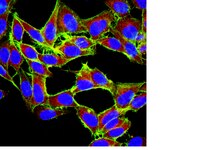05-1564 Sigma-AldrichAnti-mTOR Antibody, clone 21A12.2
Detect mTOR using this Anti-mTOR Antibody, clone 21A12.2 validated for use in WB & IC.
More>> Detect mTOR using this Anti-mTOR Antibody, clone 21A12.2 validated for use in WB & IC. Less<<Recommended Products
Overview
| Replacement Information |
|---|
Key Specifications Table
| Species Reactivity | Key Applications | Host | Format | Antibody Type |
|---|---|---|---|---|
| H | WB, ICC | M | Purified | Monoclonal Antibody |
| References |
|---|
| Product Information | |
|---|---|
| Format | Purified |
| Control |
|
| Presentation | Purified mouse monoclonal in buffer containing 0.1 M Tris-Glycine (pH7.4), 150 mM NaCl, with 0.05% sodium azide. |
| Quality Level | MQ100 |
| Physicochemical Information |
|---|
| Dimensions |
|---|
| Materials Information |
|---|
| Toxicological Information |
|---|
| Safety Information according to GHS |
|---|
| Safety Information |
|---|
| Storage and Shipping Information | |
|---|---|
| Storage Conditions | Stable for 1 year at 2-8ºC from date of receipt. |
| Packaging Information | |
|---|---|
| Material Size | 100 µg |
| Transport Information |
|---|
| Supplemental Information |
|---|
| Specifications |
|---|
| Global Trade Item Number | |
|---|---|
| Catalog Number | GTIN |
| 05-1564 | 04053252402548 |
Documentation
Anti-mTOR Antibody, clone 21A12.2 SDS
| Title |
|---|
Anti-mTOR Antibody, clone 21A12.2 Certificates of Analysis
| Title | Lot Number |
|---|---|
| Anti-mTOR, clone 21A12.2 | 2476749 |
| Anti-mTOR, clone 21A12.2 - 2376018 | 2376018 |
| Anti-mTOR, clone 21A12.2 - 2000824 | 2000824 |
| Anti-mTOR, clone 21A12.2 - 2278558 | 2278558 |
| Anti-mTOR, clone 21A12.2 - 3204243 | 3204243 |
| Anti-mTOR, clone 21A12.2 - 3273620 | 3273620 |
| Anti-mTOR, clone 21A12.2 - 3323746 | 3323746 |
| Anti-mTOR, clone 21A12.2 - 3660411 | 3660411 |
| Anti-mTOR, clone 21A12.2 - 3852337 | 3852337 |
| Anti-mTOR, clone 21A12.2 - 4112558 | 4112558 |









